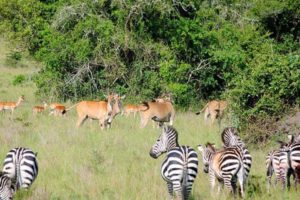
Akagera National Park is named after the Akagera river which flows along its eastern boundary. Historical events have taken their toll on this park, causing devastating harm to the environment, however, in recent years Akagera has been uplifted and is today once again seen as one of the most scenic savanna reserves in Africa. Akagera national park is also the largest protected wetland in Africa, containing lakes lined with forests, papyrus swamps, savannah plains and sprawling highlands. Here visitors can expect incredible bird watching and free roaming zebra, as well as sightings of leopard, hyena, jackal and lion.
Akagera is almost unrecognisable today compared to just 20 years ago when it was on the verge of being lost forever. While peace was finally restored in the 1990s after the 1994 Genocide, Akagera’s demise was just beginning. Refugees returning to Rwanda after the genocide were still battling for their own survival and turned to the forests for timber, wildlife for protein and the wild savannas for their livestock. Lions were hunted to local extinction, rhinos disappeared, and the park’s wildlife was displaced by tens of thousands of long-horned cattle. Biodiversity was practically lost, and with it so was employment and tourism. The park’s value was virtually diminished, which makes its story of revival even more remarkable.
In 2010, African Parks assumed management of Akagera national park in partnership with the Rwanda Development Board (RDB), shifting the park’s trajectory from one of oblivion to prosperity and hope. After years of preparation, through effective law enforcement and management, 2017 saw the historic return of 18 Eastern black rhinoceros after a 10-year absence, thanks to the support from the Howard G. Buffett Foundation. An additional five captive-bred black rhinos were translocated from Europe in June 2019, with the support of the European Association of Zoos and Aquaria (EAZA), to augment the genetic diversity. Two new male lions were also translocated to Akagera in 2017 to enhance the genetic diversity of the growing pride, which has now tripled since their initial reintroduction in 2015. With poaching essentially halted, the park’s key wildlife populations have continued to rise. The park is generating more than US$2.5M in annual revenue, making it 90% self-financing driven by the tens of thousands of people, half of whom are nationals, coming to see its rebirth.
